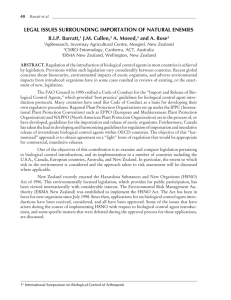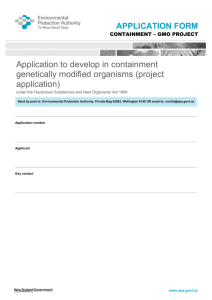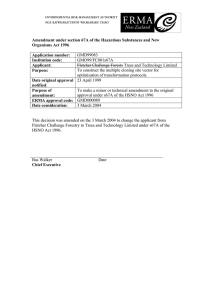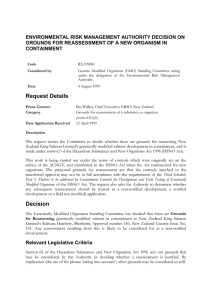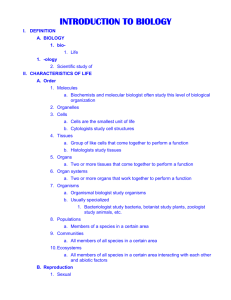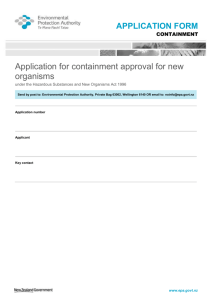ENVIRONMENTAL RISK MANAGEMENT AUTHORITY DECISION
advertisement
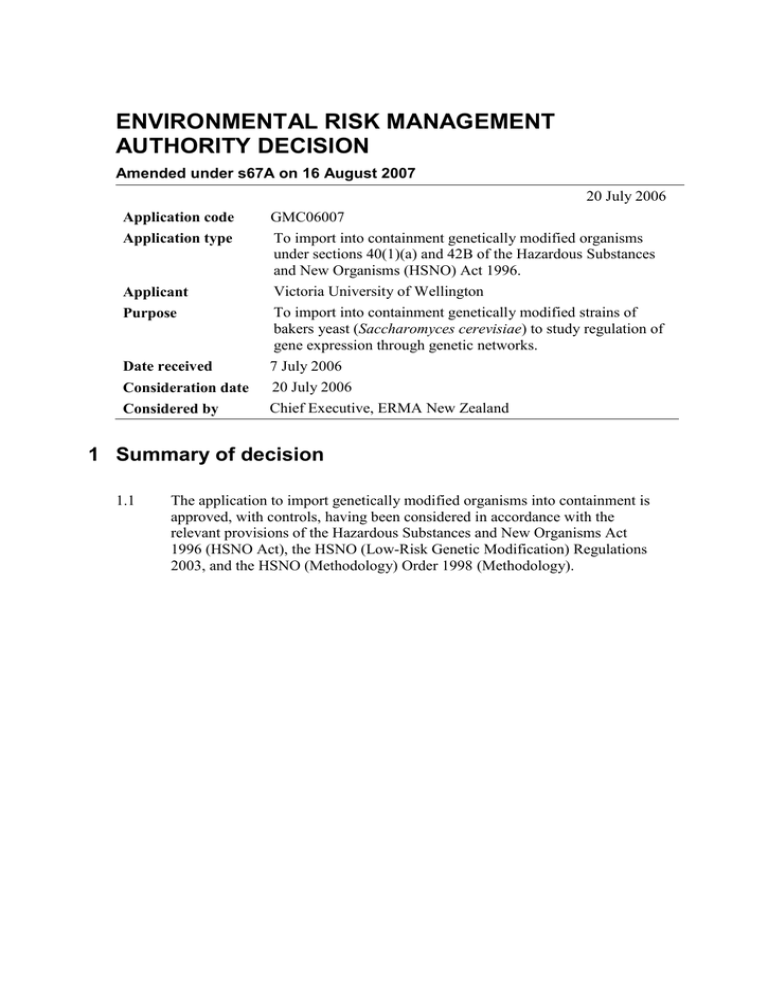
ENVIRONMENTAL RISK MANAGEMENT AUTHORITY DECISION Amended under s67A on 16 August 2007 20 July 2006 GMC06007 To import into containment genetically modified organisms under sections 40(1)(a) and 42B of the Hazardous Substances and New Organisms (HSNO) Act 1996. Victoria University of Wellington Applicant To import into containment genetically modified strains of Purpose bakers yeast (Saccharomyces cerevisiae) to study regulation of gene expression through genetic networks. 20 7 July 2006 Date received Consideration date Ju 20 July 2006 Chief Executive, ERMA New Zealand Considered by Application code Application type 1 Summary of decision 1.1 The application to import genetically modified organisms into containment is approved, with controls, having been considered in accordance with the relevant provisions of the Hazardous Substances and New Organisms Act 1996 (HSNO Act), the HSNO (Low-Risk Genetic Modification) Regulations 2003, and the HSNO (Methodology) Order 1998 (Methodology). The organisms approved are: 1.2 The organisms approved for import into containment are the genetically modified yeast strains as listed below in Table 1: Table 1: Organisms as recorded on ERMA New Zealand Register Host organism Category Modified by one or more of the following : of host organism Saccharomyces cerevisiae Meyen ex EC Hansen (1883) non-pathogenic laboratory strains 1 Site-directed mutagenesis; Disruption of genes (random and targeted); Deletion of any gene; Insertion of Saccharomyces DNA, and/or regulatory elements as listed below the table, stably integrated into the yeast genome; Plasmids or Escherichia coli/yeast shuttle vectors with altered expression of yeast genes, by use of conditional promoters or modified regulatory sequences; Addition of protein purification and affinity tags; Incorporation of short non-coding nucleotide sequences serving as unique bar-code identifiers. Category of modification/ containment level A / PC1 Genetic material shall not include sequences derived from humans. The yeast strains may contain the following vectors: Plasmid vectors, Escherichia coli/yeast cloning and expression shuttle vectors and 2-micron circle plasmid vectors. Additional genetic material will include some or all of the classes of gene regulatory elements sourced from invertebrates, vertebrates, bacteria, viruses or bacteriophages as listed below: 1. Promoters; 2. Enhancers; 3. Transcription termination signals; 4. Operator sequences; 5. Polyadenylation signals; 6. Untranslated regions such as introns/spacers, insulators, 5’- & 3’-UTRs.; 7. Multiple cloning sites; 8. Protein purification and identification tags; 9. Affinity tags; 10. tTransactivator sequence; 11. Reporter genes; Environmental Risk Management Authority Decision: GMC06007 Page 2 of 10 12. Selectable markers; 13. Origins of replication; 14. Secretory, targeting and localisation signals; The genetic material may also contain standard and generally available regulatory elements sourced from invertebrates, vertebrates, bacteria, viruses or bacteriophages including selectable markers for geneticin resistance, kanamycin resistance, and nourseothricin resistance, and nutritional markers. Background Information 1.3 The purpose of this application is to import into containment collections of genetically modified yeast strains (Saccharomyces cerevisiae) to study through network analysis the interactions of genes and their products and how these affect or contribute to the organism’s phenotype. 1.4 Network analysis requires analysing the contributions of all the organism’s genes. Yeast strains in which genes and the expression of gene products have been altered by a range of modifications including mutations, deletions, and insertions of regulatory elements, plasmids and/or affinity purification tags, will be used as a suite of tools for network analysis of the yeast genome. 1.5 The modified strains will be used to manipulate how yeast genes and their products are expressed and localised. Through pairwise interactions of the different strains, the applicant is able to determine the network combinations of genes effecting and affecting the organism’s phenotype. Information from the use of these strains can be collated to provide an understanding on the network processes underpinning yeast gene expression. 2 Legislative Criteria for Application 2.1 The application was lodged pursuant to section 40(1)(a) of the HSNO Act and determined according to the rapid assessment provisions of section 42B of the HSNO Act. 2.2 The application has been approved with controls by Mr Rob Forlong, Chief Executive of ERMA New Zealand, under delegation from the Authority as provided for in section 19 of the HSNO Act. 2.3 In reaching this decision I have considered matters relevant to the purpose of the Act, as specified in Part II, and followed the relevant provisions of the Methodology. Environmental Risk Management Authority Decision: GMC06007 Page 3 of 10 3 Consideration Sequence of the consideration 3.1 The application was formally received and verified as containing sufficient information on 7 July 2006. 3.2 The decision was based on the information supplied by the applicant in their application form Import into Containment low risk genetically modified organisms by rapid assessment. 3.3 The application was considered by the Chief Executive of ERMA New Zealand, in consultation with the Acting Manager, Māori and other relevant parties within ERMA New Zealand. 3.4 The import of the genetically modified organisms described above (Table 1) meet the criteria of a low-risk genetic modification specified in the Regulations made under section 41 of the HSNO Act, being the HSNO (Low-Risk Genetic Modification) Regulations 2003. 3.5 In reaching my decision I have used information that is relevant and appropriate to the scale and significance of the risks, costs, and benefits associated with the genetic modifications and matters relevant to the purpose of the HSNO Act 1996, as specified in Part II, and followed the relevant provisions of the Methodology. 3.6 In accordance with section 42B of the HSNO Act for rapid assessment, the approach adopted was to identify the circumstances of the genetic modification, to evaluate these against the criteria specified in section 41 of the HSNO Act, and to consider whether there are any residual risks that require further consideration. This approach covered the following issues: Purpose of the application (section 39 of the HSNO Act) Assessment against the criteria for low-risk genetic modifications (section 42B of the HSNO Act) Identification and assessment of the risks and other impacts of the organism Precedents Proposed controls 3.7 The Department of Conservation (DoC) was notified upon receipt of this application. 3.8 DoC did not comment on this application. Environmental Risk Management Authority Decision: GMC06007 Page 4 of 10 Purpose of the application 3.9 To import into containment genetically modified strains of bakers yeast (Saccharomyces cerevisiae) to study regulation of gene expression through genetic networks. 3.10 I have determined that this application may be approved for the purpose of the import of any new organism as provided for in section 39(1)(a) of the HSNO Act 1996. Category of low-risk genetic modification 3.11 I am satisfied that the genetically modified organism described above in Table 1, meets the criteria for a low-risk genetic modification specified in clause 5 of the Regulations made under section 41 of the HSNO Act, being the HSNO (Low-Risk Genetic Modification) Regulations 2003. 3.12 Non-pathogenic laboratory strains of Saccharomyces cerevisiae are considered Category 1 host organisms1 that are unlikely to cause disease in humans, animals, plants or fungi. The development of these genetically modified yeast strains constitute a Category A genetic modification, as defined in clause 5(1) under the HSNO (Low-Risk Genetic Modification) Regulations 2003, as it involved a Category 1 host organism and hence, containment is set at a minimum of Physical Containment 1 (PC1). The modifications are not expected to increase the pathogenicity, virulence or infectivity of the yeast strains and will not result in these strains having a greater ability to escape from containment. 4 Identification and assessment of the risks, costs and other impacts of the organism 4.1 I consider that the information provided by the applicant is relevant and appropriate to the scale and significance of the risks, costs, and benefits associated with the application (as required by clause 8 of the Methodology). In accordance with clauses 9 and 10 of the Methodology the information supplied by the applicant has been evaluated as follows: 4.2 I consider that, taking into account the biological characteristics of the organisms and the controls attached to this approval, there is no evidence for, nor any reason to expect, any non-negligible adverse effects of the proposed genetically modified organisms on humans, animals, plants, other organisms or the environment. 1 HSNO (Low-Risk Genetic Modification) Regulations 2003 Environmental Risk Management Authority Decision: GMC06007 Page 5 of 10 4.3 I have considered the potential Māori cultural effects in accordance with sections 6(d) and 8 of the HSNO Act and clauses 9(b)(i), 9(c)(iv) of the HSNO Methodology Order 1998: Information Used by the Authority, in consultation with the Manager, Māori. 4.4 In accordance with ERMA New Zealand policy, the applicant was not required to consult with Māori as the application is for the import into containment of genetic material that is not human in origin nor is it sourced from native or valued taonga flora and fauna. Taking this into account I consider that this genetic material poses negligible risk of adverse effects to the relationship of Māori culture and traditions with their ancestral lands, water, sites, waahi tapu, valued flora and fauna, and other taonga. Precedents 4.5 I must consider each application on its merits, and am therefore not bound by the stance taken in previous decisions. I note that there are several approvals to import genetically modified laboratory yeast strains into containment, such developments have been considered and approved on many occasions by Institutional Biological Safety Committees (IBSCs) under delegated authority and by the Chief Executive of ERMA New Zealand. 4.6 I consider that this current application does not raise any novel issues that would warrant it being considered other than via section 42A of the Act. Containment 4.7 The genetically modified Saccharomyces cerevisiae strains do not contain infectious agents pathogenic to humans, animals, plants or fungi and are Category 1 host organisms that have undergone a Category A genetic modification and shall be contained under a minimum of PC1 containment. 4.8 The Environmental Risk Management Authority holds the current version of Victoria University of Wellington’s containment manual. 4.9 The imported S. cerevisiae strains will be housed and grown under a minimum of physical containment level 1 (PC1) as described in the standard AS/NZS 2243.3.2002. The construction, operation and management of the containment facility shall be in accordance with the: a. Ministry of Agriculture and Forestry (MAF) Regulatory Authority/ERMA New Zealand Standard 154.03.022: Containment Facilities for Microorganisms. b. Australian New Zealand Standard AS/NZS 2243:3 2002 Safety in Laboratories: Part 3: (Microbiological aspects and containment facilities)3, excluding those deviations specified in section 4.2 of Standard 154.03.02. 2 3 Or any updated Standard endorsed by ERMA New Zealand and MAF Biosecurity New Zealand. Or any updated version Environmental Risk Management Authority Decision: GMC06007 Page 6 of 10 5 Decision 5.1 I am satisfied that this application is for one of the purposes specified in section 39(1) of the Hazardous Substances and New Organisms Act 1996, being section 39(1)(a): the import of any new organism. 5.2 Based on consideration and analysis of the information provided, and having considered the characteristics of the organisms, the modification and the criteria for low-risk genetic modification detailed in the HSNO (Low-Risk Genetic Modification) Regulations 2003, I am of the view that the organisms meet the criteria for rapid assessment under section 42B of the Hazardous Substances and New Organisms Act 1996. 5.3 I am satisfied that the proposed containment regime and the controls imposed in accordance with section 42B(2) of the Hazardous Substances and New Organisms Act 1996, as set out below, will adequately contain the organisms. 5.4 Pursuant to section 42B(2) of the HSNO Act 1996, and acting under delegation from the Authority provided for in section 19 of the HSNO Act 1996, I have approved this application subject to the controls specified herein. 5.5 In reaching this decision I have relied upon the following criteria in the HSNO Act and the Methodology: Criteria for assessing the purpose of the application (section 39 of the HSNO Act 1996). Criteria for rapid assessment of adverse effects for the import of a genetically modified organism in containment (section 42B of the HSNO Act 1996). Criteria for a low-risk genetic modification specified in the HSNO (LowRisk Genetic Modification) Regulations 2003, made under section 41 of the HSNO Act 1996. The information provided by the applicant was assessed against the criteria in clauses 9, 10 and 12 of the HSNO (Methodology) Order 1998. Matters to be addressed by containment controls for import of genetically modified organisms specified in Part 1 of the Third Schedule to the Hazardous Substances and New Organisms Act 1996. Environmental Risk Management Authority Decision: GMC06007 Page 7 of 10 6 Controls 6.1 In order to provide for the matters detailed in Part 1 of the Third Schedule of the HSNO Act4, Containment Controls for Importation, Development and Field Testing of Genetically Modified Organisms, the approved organisms are subject to the following controls: 1 To limit the likelihood of any accidental release of any organism or any viable genetic material5. 1.1 The approved organisms shall be imported and maintained within a containment facility which complies with these controls. 1.2 The person responsible for a particular research area and/or the person responsible for the operation of the containment facilities (‘the facility’) shall inform all personnel involved in the handling of the organisms of the Authority’s controls. 1.3 The containment facility shall be approved by the Ministry of Agriculture and Forestry (MAF), in accordance with section 39 of the Biosecurity Act and the MAF/ERMA New Zealand Standard 154.03.026: Containment Facilities for Microorganisms. 1.4 The construction, operation, and management of the microorganism containment facility shall be in accordance with the: a) Ministry of Agriculture and Forestry (MAF)/ERMA New Zealand Standard 154.03.026: Containment Facilities for Microorganisms. b) Australian New Zealand Standard AS/NZS 2243:3 20026 Safety in Laboratories: Part 3: (Microbiological aspects and containment facilities), excluding those deviations specified in section 4.2 of Standard 154.03.026. c) A minimum of Physical Containment Level 1 (PC1) requirements of the above Standards. 2 To exclude unauthorised people from the facility: 2.1 The identification of entrances, numbers of and access to entrances, and security requirements for the entrances and the facility shall be in compliance with the requirements of the standards listed in control 1.3 and 1.4 of this document. 4 Bold headings in the following text refer to Matters to be Addressed by Containment Controls for Import and Field Testing of Genetically Modified Organisms, specified in the Third Schedule of the HSNO Act 1996. 5 Viable Genetic Material is biological material that can be resuscitated to grow into tissues or organisms. It can be defined to mean biological material capable of growth even though resuscitation procedures may be required, e.g. when organisms or parts thereof are sub lethally damaged by being frozen, dried, heated, or affected by chemical. 6 Any reference to this standard in these controls refers to any subsequent version approved or endorsed by ERMA New Zealand Environmental Risk Management Authority Decision: GMC06007 Page 8 of 10 3 To exclude other organisms from the facility and to control undesirable and unwanted organisms within the facility: 3.1 The exclusion of other organisms from the facility and the control of undesirable and unwanted organisms within the facility shall be in compliance with the standards listed in control 1.4. 4 To prevent unintended release of the organism by experimenters working with the organism: 4.1 The prevention of unintended release of the organisms by experimenters working with the organisms shall be in compliance with the standards listed in control 1.4. 5 To control the effects of any accidental release or escape of an organism: 5.1 Control of the effects of any accidental release or escape of the organisms shall be in compliance with the standards listed in control 1.4 as stated above. 5.2 In the event of any breach of containment the contingency plan for the attempted retrieval or destruction of any viable material of the organisms that have escaped shall be implemented immediately. The contingency plan shall be included in the containment manual in accordance with the Standards. 5.3 If a breach of containment occurs, the facility operator must ensure that the MAF Inspector responsible for supervision of the facility has received notification of the breach within 24 hours. 6 Inspection and monitoring requirements for containment facilities: 6.1 The inspection and monitoring requirements for containment facilities shall be in compliance with the standards listed in control 1.3 and 1.4 as stated above. 7 Qualifications required of the persons responsible for implementing those controls: 7.1 The training of personnel working in the facility shall be in compliance with the standards listed in control 1.4. Mr Rob Forlong Chief Executive ERMA New Zealand Date: 20 July 2006 Approval code (BCH code): GMC001305 (15465) Environmental Risk Management Authority Decision: GMC06007 Page 9 of 10 Amendment: November 2006 Changes to controls: Addition of footnotes to the containment facility references and the Australian/New Zealand containment facility references to “future proof” the decision Standardise the wording of the breach of containment control ____________________________ Mr Rob Forlong Chief Executive, ERMA New Zealand Environmental Risk Management Authority Decision: GMC06007 16 August 2007 Date: Page 10 of 10
